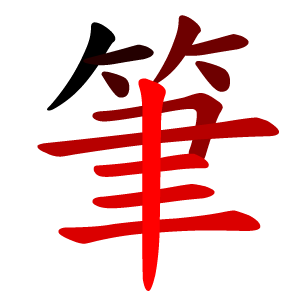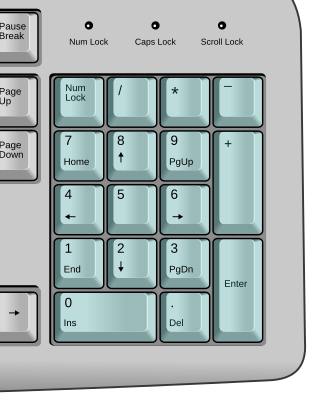Chinese input methods for computers are methods that allow a computer user to input Chinese characters. Most, if not all, Chinese input methods fall into one of two categories: phonetic readings or root shapes. Methods under the phonetic category usually are easier to learn but are less efficient, thus resulting in slower typing speeds because they typically require users to choose from a list of phonetically similar characters for input, whereas methods under the root shape category allow very precise and speedy input but have a steep learning curve because they often require a thorough understanding of a character's strokes and composition.

The Wubizixing input method, often abbreviated to simply Wubi or Wubi Xing, is a Chinese character input method primarily for inputting simplified Chinese and traditional Chinese text on a computer. Wubi should not be confused with the Wubihua (五笔画) method, which is a different input method that shares the categorization into five types of strokes.
Big-5 or Big5 is a Chinese character encoding method used in Taiwan, Hong Kong, and Macau for traditional Chinese characters.

The cent is a monetary unit of many national currencies that equals 1⁄100 of the basic monetary unit.

The Cangjie input method is a system for entering Chinese characters into a computer using a standard computer keyboard. In filenames and elsewhere, the name Cangjie is sometimes abbreviated as cj.

The Four-Corner Method or Four-Corner System is a character-input method used for encoding Chinese characters into either a computer or a manual typewriter, using four or five numerical digits per character.

Stroke order is the order in which the strokes of a Chinese character are written. A stroke is a movement of a writing instrument on a writing surface. Chinese characters are used in various forms in Chinese, Japanese, and Korean. They are known as Hanzi in (Mandarin) Chinese, kanji in Japanese (かんじ), and Hanja in Korean (한자).

Boshiamy is a Chinese character input method editor (IME). It was invented by Liu Chung-tz'u (劉重次).

The Stroke Count Method, Wubihua method, Stroke input method or Bihua IME is a relatively simple Chinese input method for writing text on a computer or a mobile phone. It is based on the stroke order of a word, not pronunciation. It uses five or six buttons, and is often placed on a numerical keypad. Although it is possible to input Traditional Chinese characters with this method, this method is often associated with Simplified Chinese characters. The Wubihua method should not be confused with the Wubi method.

Dayi is a system for entering Chinese characters on a standard QWERTY keyboard using a set of 46 character components. A character is built by combining up to four of the 46 characters, using a system similar to that of Cangjie, but is decomposed in stroke order instead of in geometric shape in Cangjie.
The Chinese character description languages are several proposed languages to most accurately and completely describe Chinese characters and information such as their list of components, list of strokes, their order, and the location of each of them on a background empty square. They are designed to overcome the inherent lack of information within a bitmap description. This enriched information can be used to identify variants of characters that are unified into one code point by Unicode and ISO/IEC 10646, as well as to provide an alternative form of representation for rare characters that do not yet have a standardized encoding in Unicode or ISO/IEC 10646. Many aim to work for Kaishu style and Song style, as well as to provide the character's internal structure which can be used for easier look-up of a character by indexing the character's internal make-up and cross-referencing among similar characters.
The Q9 input method, invented by Qcode Information Technology Ltd. of Hong Kong, is an input method that uses only the number keys on a numeric keypad to input Chinese characters into a digital device. It is considered an easy method to use even though it is a "structural" input method. It is used on some mobile phones in Hong Kong. It provides an alternative to Cangjie input method as well, as this utilizes the numeric keypad on personal computers.

Japanese input methods are used to input Japanese characters on a computer.
On personal computers with numeric keypads that use Microsoft operating systems, such as Windows, many characters that do not have a dedicated key combination on the keyboard may nevertheless be entered using the Alt code. This is done by pressing and holding the Alt key, then typing a number on the keyboard's numeric keypad that identifies the character and then releasing Alt.
ISO/IEC 9995Information technology — Keyboard layouts for text and office systems is an ISO/IEC standard series defining layout principles for computer keyboards. It does not define specific layouts but provides the base for national and industry standards which define such layouts.

The Chinese telegraph code, Chinese telegraphic code, or Chinese commercial code is a four-digit decimal code for electrically telegraphing messages written with Chinese characters.

Unicode input is the insertion of a specific Unicode character on a computer by a user; it is a common way to input characters not directly supported by a physical keyboard. Unicode characters can be produced either by selecting them from a display or by typing a certain sequence of keys on a physical keyboard. In addition, a character produced by one of these methods in one web page or document can be copied into another. In contrast to ASCII's 96 element character set, Unicode encodes hundreds of thousands of graphemes (characters) from almost all of the world's written languages and many other signs and symbols besides.

A numeric keypad, number pad, numpad, or ten key, is the palm-sized, usually-17-key section of a standard computer keyboard, usually on the far right. It provides calculator-style efficiency for entering numbers. The idea of a 10-key number pad cluster was originally introduced by Tadao Kashio, the developer of Casio electronic calculators.

Lin Yutang's Chinese-English Dictionary of Modern Usage, compiled by the linguist and author Lin Yutang, contains over 8,100 character head entries and 110,000 words and phrases, including many neologisms. Lin's dictionary made two lexicographical innovations, neither of which became widely used. Collation is based on his graphical "Instant Index System" that assigns numbers to Chinese characters based on 33 basic calligraphic stroke patterns. Romanization of Chinese is by Lin's "Simplified National Romanization System", which he developed as a prototype for the Gwoyeu Romatzyh or "National Romanization" system adopted by the Chinese government in 1928. Lin's bilingual dictionary continues to be used in the present day, particularly the free online version that the Chinese University of Hong Kong established in 1999.
Chinese character order, or Chinese character indexing, Chinese character collation and Chinese character sorting, is the way in which a Chinese character set is sorted into a sequence for the convenience of information retrieval. It may also refer to the sequence.













